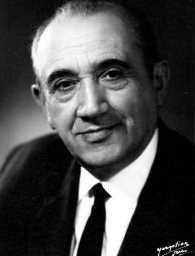Mikael Mazmanyan
Wednesday, July 23, 2025
In 1918, he graduated from the Nersisian School in Tiflis. In 1921, he was admitted to VKhUTEMAS in Moscow and graduated from VKhUTEIN in 1929. In 1916, under the direction of Nicholas Marr in Ani, he copied the frescoes of the Church of Tigran Honents. He participated in the first (1917) and second (1919) exhibitions organized in Tiflis by the Union of Armenian Artists.
In 1924, together with Karo Halabyan, he designed stage sets in Yerevan for productions at the First State Theater of Armenia, including Anatoly Lunacharsky’s Red Mask and Derenik Demirchyan’s play Kaj Nazar. He also translated works such as Plekhanov’s Art and Social Life, among others.
From 1929 to 1932, he was one of the founding members of VOPRA (All-Union Association of Proletarian Architects) in Moscow and OPRA in Yerevan. Between 1930 and 1935, he served as the first director of the Yerevan Institute of Construction. From 1932 to 1937, simultaneously, he co-led the architectural studio of the “Giprogor” design bureau (with Gevorg Kochar).
Starting in 1954, he worked with the Executive Committee of the Yerevan City Council, and from 1958 to 1970, he headed architectural planning studios at the "YerevanProject" Institute. From 1957 to 1971, he was the chairman of the Architectural and Construction Commission of the Mother See of Holy Etchmiadzin.
He developed master plans for several cities located in complex terrains, including Kapan (1930, as well as the urban planning of Banavan), Noravan, Sisian, Tatev, Shinuhayr, Vanadzor (1934–1937), Alaverdi (1929–1930), and Gyumri (1932–1937).
According to designs by Mikael Mazmanyan (in collaboration with co-authors), the following buildings were constructed in Yerevan:
-
Builders' Club (1928–1929), now home to the Russian Theater and the Committee for Physical Culture and Sports
-
House of State Publishing (Petapi Tun) (1930)
-
Residential "Chessboard" Building (1930–1932), known for its checkered facade design
-
Central Department Store (TSUM) (1936–1937)
-
The State Publishing Complex (Grapalat) (1935–1940; construction completed in 1960)
-
Ajapnyak Residential District (1955–1965)
In 1939, Mazmanyan was forcibly relocated to the far north of the USSR. There, alongside Gevorg Kochar, he designed the master plans for the first polar cities — Norilsk and Dudinka — and worked there until 1954.
Under Mazmanyan’s leadership, detailed urban plans were developed for various districts of Yerevan (1955–1969), including the detailed layout of the city center (1967–1968) and a general master plan for a population of 1 million.





